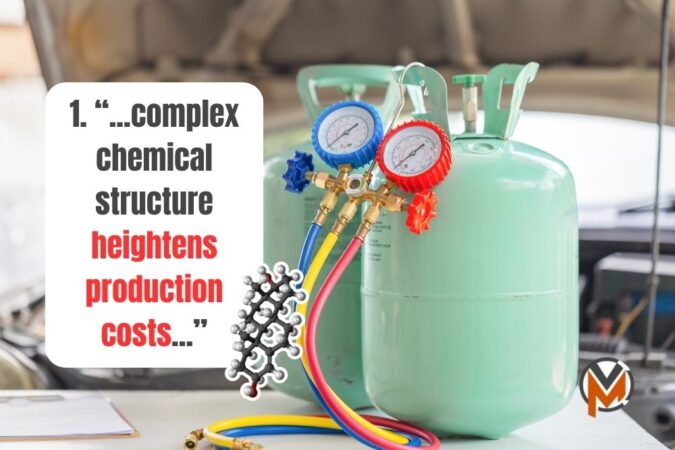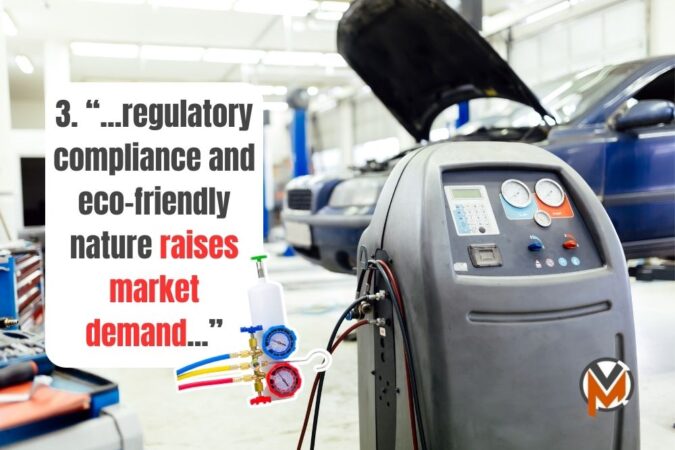R1234YF refrigerant recharges for vehicles are pricier than its predecessors, given the fact that R1234YF is more complex and expensive to produce, not to mention its fairly limited supply and market changes over the past few years, as well as regulatory incentives and credits for automakers to make the switch to using more eco-friendly AC refrigerants for their cars.
For the sake of offsetting the ever-increasing threat of global warming, automakers have begun making the switch to more eco-friendly R1234YF refrigerant. However, why is R1234YF AC refrigerant so expensive?
If you’ve sent your car for an AC recharge recently and you’re shocked by how expensive it’s gotten lately, it’s not just you. Others, like myself, have noticed it, too. There are a few reasons why R1234YF is far more expensive.

R1234YF refrigerant is more complex and pricier to produce, and not many companies were able to produce R1234YF at first, thus leading to a constrained supply chain. But, with more competition, this may change.

- Why Switch To R1234YF Refrigerant?
- Reasons Why 1234YF Costs More
- Are There Any Cheaper Alternatives?
R1234YF Refrigerant
One of the things that many folks wonder, is why make the switch to R1234YF refrigerant, anyway? Besides, what’s wrong with the old R-134a refrigerants that we’ve been using for car air conditioners in the past?

Well, it comes down to environmental sustainability, of which automotive air conditioning refrigerants are a significant contributor. This is why R1234YF has since been developed, which is a more eco-friendly option.
R1234YF has a much lower Global Warming Potential (GWP) than its predecessor, R-134a. This new shift is now a must, not just for its environmental impact, but also for regulatory requirements in many regions.

Most parts of the world, mainly in the US and Europe, now require the use of R1234YF refrigerants. Though, while R1234YF is a forward-looking and more eco-friendly choice, consumers are forced to pay the price.
R1234YF Freon Cost
With that in mind, here are some key reasons why R1234YF refrigerant costs so much (particularly so when compared to R-134a and older refrigerants – R1234YF recharges typically cost between $400 and $600):

TL;DR, the higher prices are attributed to the result of its high production requirements, market dynamics influenced by limited suppliers and patent protections, and the global shift towards eco-friendly solutions.
Reason #1: Production Complexity And Costs

R1234YF’s chemical structure is more sophisticated compared to traditional refrigerants. This complexity necessitates advanced manufacturing processes and precision, which elevates production costs.
Moreover, R1234YF’s production must adhere to strict safety & environmental regulations due to its mildly flammable nature and low GWP. Compliance with these regulations adds to the manufacturing expense.

Plus, all the equipment required to produce R1234YF is more specialized and costly, reflecting the need for precise control over chemical processes and quality assurance. This further adds to the cost.
Reason #2: Market Dynamics And Limited Suppliers

Initially, the production of R1234YF was protected under patents held by a few companies, thus limiting the number of manufacturers. This lack of competition and quasi-monopoly naturally led to higher prices.
Furthermore, as of now, the market for R1234YF is still growing. As such, it hasn’t reached the economies of scale that older refrigerants have achieved. This means that the per-unit cost of production remains high.

Not to mention, the initial investment in developing and setting up production facilities for R1234YF remains substantial. Manufacturers are likely aiming to recover these investments, contributing to the higher cost.
Reason #3: Regulatory Credits And Manufacturer Preferences


Governments and regulatory bodies offer credits and incentives to automakers for using environmentally friendly products like R1234YF. These incentives and subsidies are designed to offset the higher costs.
But, they also indirectly contribute to the higher price as they create a guaranteed market for the product. Additionally, many countries are moving towards much stricter environmental standards.
This basically necessitates the use of low-GWP refrigerants. This shift towards environmental compliance creates a high demand for R1234YF, further influencing its market price, which carries over to consumers.
Consequently, automakers are focused on sustainability and environmental responsibility. By adopting R1234YF, they comply with regulations and seem more eco-friendly, despite higher costs for consumers.
Are There Any Cheaper Refrigerants To Consider

So, with that being said, will every consumer today simply need to suck it up and bite the bullet with higher AC recharge prices? Or, is there a cheaper alternative for those wondering why is R1234YF so expensive?
Unfortunately, there aren’t too many options. For car owners, the decision to switch to R1234YF may come down to higher servicing & recharge costs for you, versus the lower environmental impact of R1234YF.
The high cost of R1234YF affects not only car owners requiring AC repairs, maintenance, and regular Freon recharges. On top of that, repair shops, technicians, and specialists must invest in compatible equipment.
This investment can be significant, as R1234YF requires specific handling and recovery equipment due to its mildly flammable nature. As the market for R1234YF grows, we can hope that the price gradually drops.
However, for those of you who are curious (despite its caveats), there are technically some cheaper and less expensive alternatives for R1234YF that are worth researching…

Alternative #1: Conversion To R-134a
One cost-saving alternative is converting an R1234YF system to use R-134a refrigerant. This process involves changing all your car’s AC service valve fittings and ensuring the AC system is compatible with R-134a.
However, it’s important to note that this might not be legal for all vehicles (depending on where you are and your local regulations), especially those still under warranty, and could affect the vehicle’s performance.
Alternative #2: Using R-445A Refrigerant
Another emerging, alternative refrigerant option is R-445A, a blend refrigerant with a lower cost per pound compared to R1234YF. It’s essentially a blend of R-1234ze, R-134a, and R-744 (carbon dioxide).
Subsequently, it offers a lower global warming potential (GWP) than just pure R-134a. However, this option is still in pretty early development, and this type of refrigerant may not be widely available yet.
















